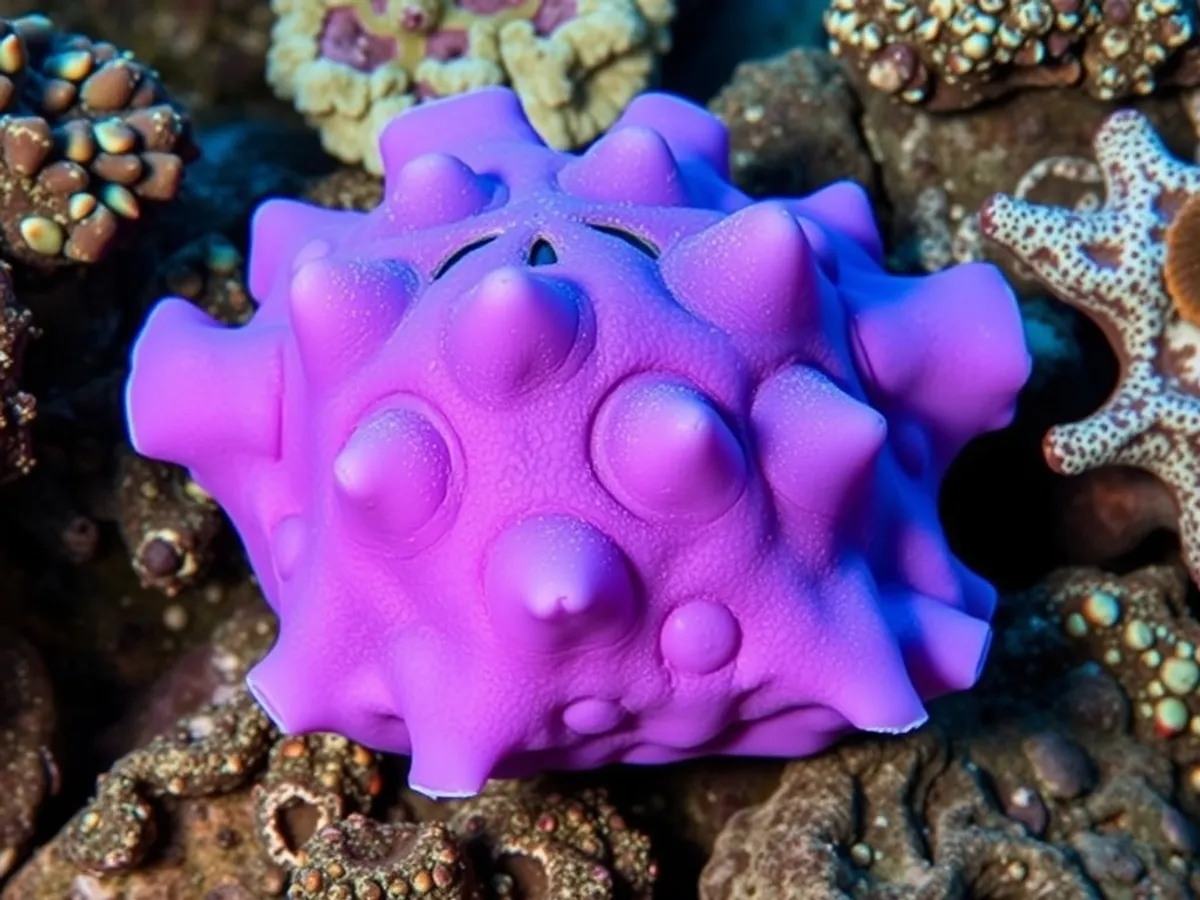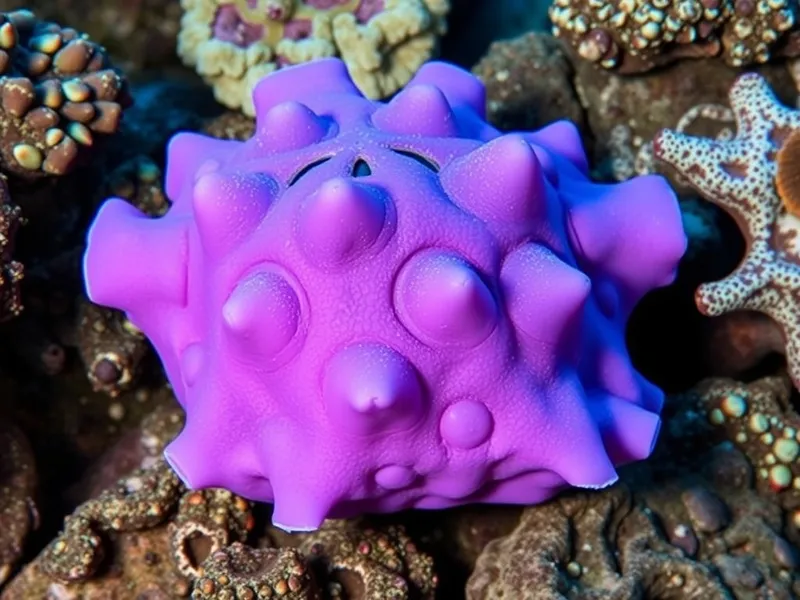
Sea Apple
Pseudocolochirus violaceus

Meet the Sea Apple
The Sea Apple is a vividly colored sea cucumber native to the Indo-Pacific region, known for its striking purple, red, and yellow hues. This fascinating invertebrate uses feathery tentacles to filter plankton and organic particles from the water. When threatened, it can expel sticky threads or even release toxins as a defense mechanism. Sea Apples are popular in the aquarium trade, but their sensitive nature and toxic defenses require expert care.
Classification
Invertebrate
Habitat
Shallow coastal reefs
Diet
Filter Feeder
Lifespan
5-10 years
Conservation
Least Concern
Weight
200-400 grams
📖Fascinating Facts
Dazzling Colors
Sea Apples display brilliant purple, red, blue, and yellow patterns that serve as a warning to predators about their potential toxicity.
Unusual Defense
When threatened, Sea Apples can expel sticky Cuvierian tubules or release toxic chemicals into the water to deter predators.
Regeneration Power
Sea Apples can regenerate entire organs and body parts if lost or expelled, a remarkable adaptation to survive predation or environmental stress.
📋Detailed Description
Pseudocolochirus violaceus, commonly known as the Sea Apple, is a holothuroid echinoderm distinguished by its vibrant coloration, typically exhibiting a combination of deep purple, red, yellow, and sometimes blue patterns. Adults generally reach 7–15 cm in length, with a soft, cylindrical body encased in a thick, leathery skin. The anterior end features a crown of 8–10 highly branched, retractable feeding tentacles, which are specialized tube feet adapted for filter feeding. Internally, Sea Apples possess a unique respiratory tree system for gas exchange, and a mutable collagenous tissue that allows them to alter body rigidity. They are primarily nocturnal, remaining hidden in reef crevices during the day and extending their tentacles at night to capture plankton. When threatened, they can expel Cuvierian tubules—sticky, toxic threads—or release holothurin toxins into the water, which can be lethal to nearby fish and invertebrates. Sea Apples are solitary and sedentary but may aggregate in areas with strong currents that facilitate feeding. Reproduction is achieved via broadcast spawning, with external fertilization and a planktonic larval stage. Their striking appearance and unique defense mechanisms make them a subject of interest in both marine biology and the aquarium trade, though their sensitivity to environmental changes poses challenges for captive care.
💡 Did you know?
If extremely stressed, Sea Apples can expel all of their internal organs in a process called evisceration, and later regenerate them completely.
🔬Research & Sources
🎭Behavior & Social Structure
Sea Apples are primarily sedentary, anchoring themselves to rocks or coral rubble using their tube feet. They extend their feathery oral tentacles into the water column to capture suspended plankton and detritus, retracting the tentacles one by one to ingest food. Feeding activity peaks at night or during periods of strong water movement, which brings more food particles within reach. They exhibit little social interaction, typically maintaining solitary territories, though multiple individuals may be found in optimal feeding locations. When disturbed, they may contract their bodies, retract their tentacles, or, in extreme cases, expel Cuvierian tubules or release toxins. Locomotion is slow and limited, primarily involving subtle crawling or repositioning in response to current changes or food availability.
👶Reproduction & Life Cycle
Pseudocolochirus violaceus reproduces sexually via broadcast spawning, typically synchronized with lunar cycles and seasonal changes in water temperature. During spawning events, males and females release sperm and eggs into the water column, where external fertilization occurs. The fertilized eggs develop into planktonic auricularia larvae, which drift with ocean currents for several weeks before settling onto the substrate and metamorphosing into juvenile sea cucumbers. There is no parental care post-spawning, and juvenile survival rates are heavily influenced by predation and environmental conditions. Spawning events are often observed in late spring to early summer in the Indo-Pacific region.
🛡️Adaptations & Survival
Sea Apples possess several notable adaptations for survival in dynamic reef environments. Their vivid coloration serves as aposematic (warning) signaling to potential predators, indicating their toxicity. The ability to expel Cuvierian tubules provides a physical and chemical deterrent, while the release of holothurin toxins can rapidly incapacitate or kill nearby fish, discouraging predation. Their branched tentacles are highly efficient at capturing suspended food particles, and their mutable collagenous tissue allows them to alter body firmness, aiding in crevice dwelling and predator evasion. Additionally, their respiratory tree system enables efficient gas exchange even when buried or partially concealed.
📚Research Sources
🎨Cultural Significance
Sea Apples are not widely featured in traditional folklore or mythology, but their striking appearance has made them popular in the marine aquarium trade, particularly in Southeast Asia and Australia. In some cultures, sea cucumbers in general are valued for their purported medicinal properties, though Pseudocolochirus violaceus is not commonly used for consumption due to its toxicity. Their presence in public aquaria serves an educational role, highlighting the diversity and complexity of reef ecosystems.
🔬Recent Research & Discoveries
Recent research on Pseudocolochirus violaceus has focused on the biochemical properties of their toxins, with studies investigating potential pharmaceutical applications of holothurin compounds. Ongoing ecological research is examining their role in nutrient cycling within reef systems and their responses to environmental stressors such as ocean acidification. Genetic studies are also being conducted to clarify phylogenetic relationships within the family Cucumariidae. Notably, advances in larval rearing techniques have improved understanding of their developmental biology, which may aid in future conservation and aquaculture efforts.
🎥Wildlife Videos

Prehistoric Planet 2 — What Do We Really Know About Ammonites? | Apple TV+
Using the present to inform the past. Prehistoric Planet Season 2 is now streaming on Apple TV+ https://apple.co/_Prehistoric ...
Apple TV

Prehistoric Planet 2 — How Fast Was A Mosasaur? | Apple TV+
Learn more about the secrets of Mosasaurs' underwater success. Prehistoric Planet Season 2 is now streaming on Apple TV+ ...
Apple TV

Sea Animals for Kids | Learn all the Animals and Plants that Live in the Sea Underwater footage|
please watch for more videos of kids leaarning *WILD ANIMALS with videoclips | Learn Wild Animals Names For Children, Kids ...
Kevin Channel

TV Presenter Swims with the Biggest Fish on the Planet | Nature Bites
Patrick Aryee dives under the surface to meet a whale shark - the planet's biggest fish. Weighing over twenty tonnes and as long ...
Nature Bites

Experiment! How Does An Owl Fly So Silently? | Super Powered Owls | BBC
Using sensitive sound equipment the team try to find out how an owl can fly so silently compared to other birds. Taken from Super ...
BBC Earth

Beibu Gulf Series | Episode 7: Sea and land
For more: https://www.cgtn.com/video Beibu Gulf is embraced by land on three sides. Mudflats and reefs connect the sea and land ...
CGTN
🌍Habitat Information
The Sea Apple typically inhabits Shallow coastal reefs environments. Sea Apples have adapted to their environments with specialized features and behaviors.
Primary Habitat:
Shallow coastal reefs
More detailed habitat information will be available soon.
🛡️Conservation Status
The Sea Apple is currently classified as Least Concern. Conservation efforts are crucial for preserving this species for future generations.
Common Threats:
- 🏠Habitat loss and fragmentation
- 🌡️Climate change impacts
- 🎯Hunting and poaching
- 🏭Human-wildlife conflict
⚠️Threats & Conservation Challenges
While currently listed as Least Concern by the IUCN, Sea Apples face localized threats from habitat degradation, pollution, and overcollection for the aquarium trade. Their sensitivity to water quality and rapid release of toxins when stressed make them vulnerable to environmental disturbances, such as coral reef decline and increased sedimentation. Climate change, leading to ocean warming and acidification, may also impact their populations indirectly by affecting plankton availability and reef health. Unsustainable harvesting for ornamental purposes poses a risk in some regions, although wild populations remain stable overall.
🔬Scientific Classification
Scientific Name
Pseudocolochirus violaceus
Classification Hierarchy
🔍 About Taxonomic Classification
Taxonomic classification is a hierarchical system used by scientists to classify and organize living organisms based on shared characteristics and evolutionary relationships.
The system moves from broad categories (Kingdom) to increasingly specific ones, with each animal's scientific name typically consisting of its Genus and species.
📝Community Notes
Share your observations and insights about the Sea Apple with our community of wildlife enthusiasts.
Join Our Community
Sign in to share your observations and connect with fellow wildlife enthusiasts.
Sign In to ContributeNo community notes yet
Be the first to share your observations about the Sea Apple!
Explore Sea Apple
Select a tab above to learn more about this amazing animal.
📸Photo Gallery
No photos available for this animal yet.
🌟Discover More Wildlife
Continue your journey of discovery with more fascinating animals from our database
